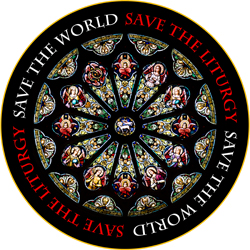I read what I think was a crackpot's rant, about Hallowe'en' candy being "cursed", and it occurred to me, wouldn't it be nice, regardless of your Butterfingers' provenance, if you blessed them, and prayed to God for His blessings on all the little porch monkeys whose teeth you'd be rotting and bellies you'd be discomfitting with it? sprinkle a little holy water or blessed salt on the, after all wrapped, candy? Just a thought...)
you might like to read what Bishop Serratelli, (head of the US CDW,) has to say on the subject of relics.
I can't seem to work the permalinks on the Peterson site, but his four columns on the subject can be accessed from the drop-down menu at the bottom of this page.
A taste:
Three important facts emerged from [the excavation of a tomb thought to be St Paul's.] First, the tomb contained traces of a precious linen cloth, purple in color and laminated with pure gold. This indicates the burial of someone highly esteemed and venerated. Second, the fragments of bones belonged to someone who lived in the first century. Third, the Basilica in honor of St. Paul was deliberately built over this tomb to which pilgrims have been coming from the beginning of the Christian era. This was no ordinary grave....
[Pope Benedict commented that] “an authentic scientific analysis seems to confirm the unanimous and uncontested tradition that these are the mortal remains of the Apostle Paul.”...
In the first century, Christians gave special respect to the tombs of martyrs. They adorned their graves with decorations to distinguish them from those of the other dead. On the anniversaries of their death, they would double the customary use of lamps near the tombs. They would also write inscriptions asking for the intercession of the martyr near the place of burial. Over the tombs of the more famous martyrs such as St. Peter and St. Paul, they built basilicas to mark the place of burial and to serve as a place of prayer. (cf. Paolinus Nolanus, Carmen 26 vv. 387-388; Prudentius, Peristephan. Hymn XI, vv. 195-210). In this way, both the resting place of the saints and their mortal remains were honored and treasured.
The tradition of respecting the remains of the saints is clearly witnessed at the very death of St. Polycarp (69 A.D.-155 A.D.). St. Polycarp was one of the immediate disciples of the Apostles.
[When he was martyred] the Christians gathered up his bones for burial. In a letter from the Church of Smyrna to the Church of Philomelium, the Smyrnaeans wrote, “We took up his bones, which are more valuable than precious stones and finer than refined gold, and laid them in a suitable place, where the Lord will permit us to gather ourselves together, as we are able, in gladness and joy, and to celebrate the birthday of his martyrdom.”
From the first century until the 16th century, Christians continued this attitude of respecting the remains of the saints....
Hmmmm, the 16th century, the 16th century.... what, shall we say, disrupted or sought to disrupt the practice, d'you suppose?
Respect for the relics of the saints is one of the unbroken traditions that Catholics share with the Orthodox. ...I wish the Bishop had expanded his theme a little more, and dealt more explicitly with how the veneration of relics relates to the Theology of the Body.
In Luther’s day, the castle church of Wittenberg boasted of many relics. On certain days, pilgrims would come to the church to ask for the intercession of the saints whose relics were placed on display. Great numbers would crowd the church as the feast of All Saints approached. No doubt, Luther made use of this ready audience when he posted his ninety-five propositions on the church’s door in 1517.
Luther was not favorable to the place of the saints in the life of the faithful. He spoke against the very idea of the intercession of the saints...
Theologians and pastors within the Catholic tradition have always recognized that misguided piety could lead to abuses in the use of relics. One of the most famous diatribes against the false use of relics came not from one the Reformers but from the Benedictine historian and theologian Guibert of Nogent (1055–1124). In his work De pignoribus sanctorum (On Saints and their Relics), he called for a close oversight of the use of relics. Nonetheless, he accepted their place within popular piety.
Anyway, these columns reminded me that I thoroughly agree with a certain CATHOLIC publication, that in giving liturgical advice suggested we find a way to celebrate Reformation Sunday.
I think we should do so by venerating the relics of the Saints.
p.s. Interesting that His Excellency mentions Lt. Col. George Custer and the other soldiers killed at Little Bighorn -- I once read an article, (in Smithsonian, IIRC,) that wrote of how the corpses at the battle were all mutilated, except for the body of one extraordinarily handsome (there was a photo, this was by anyone's standards,) Catholic officer, who bore the emblem of a papal knighthood.
It seems that some sort of mojo, whether that of Catholicism or that of physical beauty, was respected by the victors.




No comments:
Post a Comment